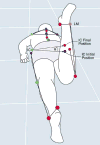Differences in lumbopelvic motion between people with and people without low back pain during two lower limb movement tests
- PMID: 18990474
- PMCID: PMC2643272
- DOI: 10.1016/j.clinbiomech.2008.09.008
Differences in lumbopelvic motion between people with and people without low back pain during two lower limb movement tests
Abstract
Background: Clinical data suggest that active limb movements may be associated with early lumbopelvic motion and increased symptoms in people with low back pain.
Methods: Forty-one people without low back pain who did not play rotation-related sports and 50 people with low back pain who played rotation-related sports were examined. Angular measures of limb movement and lumbopelvic motion were calculated across time during active knee flexion and active hip lateral rotation in prone using a three-dimensional motion capture system. Timing of lumbopelvic motion during the limb movement tests was calculated as the difference in time between the initiation of limb movement and lumbopelvic motion normalized to limb movement time.
Findings: During knee flexion and hip lateral rotation, people with low back pain demonstrated a greater maximal lumbopelvic rotation angle and earlier lumbopelvic rotation, compared to people without low back pain (P<0.05).
Interpretation: The data suggest that people with low back pain who play rotation-related sports may move their lumbopelvic region to a greater extent and earlier during lower limb movements than people without low back pain. Because people perform many of their daily activities in early to midranges of joint motion the lumbopelvic region may move more frequently across the day in people with low back pain. The increased frequency may contribute to increased lumbar region tissue stress and potentially low back pain symptoms. Lower limb movements, therefore, may be important factors related to the development or persistence of low back pain.
Conflict of interest statement
Figures
References
-
- Adams MA, Bogduk N, Burton K, Dolan P. The Biomechanics of Back Pain. Churchill Livingstone; Edinburgh, England: 2002.
-
- Baecke JA, Burema J, Frijters JE. A short questionnaire for the measurement of habitual physical activity in epidemiological studies. Am J Clin Nutr. 1982;36:936–942. - PubMed
-
- Bouisset S, Zattara M. A sequence of postural movements precedes voluntary movement. Neurosci Lett. 1981;22:263–270.
-
- Esola MA, McClure PW, Fitzgerald GK, Siegler S. Analysis of lumbar spine and hip motion during forward bending in subjects with and without a history of low back pain. Spine. 1996;21:71–78. - PubMed
Publication types
MeSH terms
Grants and funding
LinkOut - more resources
Full Text Sources
Medical



